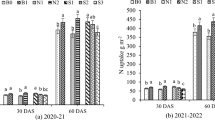Abstract.
Use of renewable N and C sources such as green manure (GM) and crop residues in rice-wheat cropping systems of South Asia may lead to higher crop productivity and C sequestration. However, information on measurements of gaseous N losses (N2O+N2) via denitrification and environmental problems such as N2O and CO2 production in rice-wheat cropping systems is not available. An acetylene inhibition-intact soil core technique was employed for direct measurement of denitrification losses, N2O and CO2 production, in an irrigated field planted to rice (Oryza sativa L.) and wheat (Triticum aestivum L.) in an annual rotation. The soil was a coarse-textured Tolewal sandy loam soil (Typic Ustochrept) and the site a semi-arid subtropical Punjab region of India. Wheat residue (WR, C:N=94) was incorporated at 6 t ha–1 and sesbania (Sesbania aculeata L.) was grown as GM crop for 60 days during the pre-rice fallow period. Fresh biomass of GM (C:N.=18) at 20 or 40 t ha–1 was incorporated into the soil 2 days before transplanting rice. Results of this study reveal that (1) denitrification is a significant N loss process under wetland rice amounting to 33% of the prescribed dose of 120 kg N ha–1 applied as fertilizer urea-N (FN); (2) integrated management of 6 t WR ha–1 and 20 t GM ha–1 supplying 88 kg N ha–1 and 32 kg FN ha–1 significantly reduced cumulative gaseous N losses to 51.6 kg N ha–1 as compared with 58.2 kg N ha–1 for 120 kg FN ha–1 alone; (3) application of excessive N and C through applying 40 t GM ha–1 (176 kg N ha–1) resulted in the highest gaseous losses of 70 kg N ha–1; (4) the gaseous N losses under wheat were 0.6% to 2% of the applied 120 kg FN ha–1 and were eight- to tenfold lower (5–8 kg N ha–1) than those preceding rice; (5) an interplay between the availability of NO3 – and organic C largely controlled denitrification and N2O flux during summer-grown flooded rice whereas temperature and soil aeration status were the primary regulators of the nitrification-denitrification processes and gaseous N losses during winter-grown upland wheat; (6) the irrigated rice-wheat system is a significant source of N2O as it emits around 15 kg N2O-N ha–1 year–1; (7) incorporation of WR in rice and rice residue (C:N=63) in wheat increased soil respiration, and increased CO2 production in WR- and GM-amended soils under anaerobic wetland rice coincided with enhanced rates of denitrification; and (8) with adequate soil moisture, most of the decomposable C fraction of added residues was mineralized within one crop-growing season and application of FN and GM further accelerated this process.
Similar content being viewed by others
Author information
Authors and Affiliations
Additional information
Electronic Publication
Rights and permissions
About this article
Cite this article
Aulakh, M.S., Khera, T.S., Doran, J.W. et al. Denitrification, N2O and CO2 fluxes in rice-wheat cropping system as affected by crop residues, fertilizer N and legume green manure. Biol Fertil Soils 34, 375–389 (2001). https://doi.org/10.1007/s003740100420
Received:
Issue Date:
DOI: https://doi.org/10.1007/s003740100420




